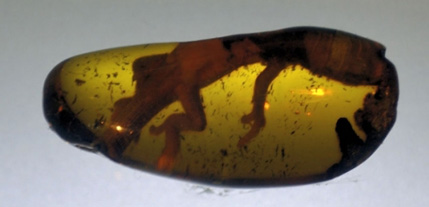Miocene Lizard Preserved in Amber
Scientists Examine New Species of Prehistoric Lizard
Being small has its advantages. For example, being able to survive a devastating global catastrophe such as an impact by an extraterrestrial object which hastened the demise of the Dinosauria. As a general rule, if a land-living organism was bigger than a Labrador sixty five million years ago, roughly the time of the disaster, then it would most likely not have survived. However, small, terrestrial creatures are rarely preserved in the fossil record.
Often their delicate skeletons are lost well before any fossilisation can take place, indeed, the carcase of any small animal is very likely to be scavenged, making a tasty mouthful for any passing predator. So it is very remarkable to read about the discovery of an entirely new species of lizard dating from the Miocene – a lizard fossil preserved in amber.
Lizard Specimen Preserved in Amber
Miocene Lizard
Researchers studying amber (fossilised tree resin), in the state of Chiapas (Mexico), from a famous location, the Simojovel amber deposits, have uncovered the complete fossilised remains of a small lizard, preserved in an amber nodule. The little lizard has been assigned to the family Dactyloidae and the genus Anolis, a diverse genera that contains something like 400 extant species.
The lizard specimen measures approximately 4.5 centimetres by 1.3 centimetres and as this little creature was trapped by sticky tree resin the fossilised specimen is virtually complete. A spokesperson from the National Autonomous University of Mexico’s Physics Institute, Francisco Riquelme stated that the discovery is particularly important as soft tissue and skin has been preserved. The lizard and a number of other significant amber fossils are on display at the Amber Museum in San Cristobal de las Casas (Chiapas State).
Evolution of Anolis Lizards
Anolis lizards today can be found throughout the south-eastern United States and the Caribbean, most of these lizards are insectivores and the discovery of such a well-preserved specimen will help scientists to understand a little more about the diversity and evolution of this type of lizard.
Director of the nearby Chiapas Palaeontology Museum, Gerardo Carbot commented that the age of the strata from which the amber was excavated dates to around 23 million years ago. A spokesperson from Everything Dinosaur suggested that the fossil might be from the Aquitanian faunal stage of the Miocene. Such discoveries are very important as they give palaeontologists an insight into the smaller creatures that inhabited this part of the world millions of years ago. Other organisms preserved in amber have included frogs, mites, spiders and insects as well as plant remains and pollen.
To read about the discovery of a one-hundred-million-year-old spider fossil preserved in amber: Spider Fossil Preserved in Amber.
Although the discovery of a lizard fossil such as this is extremely rare, the scientists are confident that other fossils in amber are likely to be found, perhaps feathers, lizard scales and other such debris from these Mexican deposits.
For dinosaur themed toys and prehistoric animal themed gifts: Everything Dinosaur.


